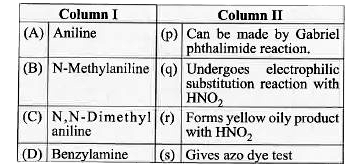Match the entries in column I with appropriate entries of column II and choose the correct option out of the four options (a), (b), (c), (d) given at the end of each question

A−s,B−r,C−q,D−p
A−q,B−p,C−s,D−r
A−p,B−q,C−r,D−s
A−r,B−s,C−p,D−q
The correct Answer is:B
Step by step video & image solution for Match the entries in column I with appropriate entries of column II and choose the correct option out of the four options (a), (b), (c), (d) given at the end of each question by Chemistry experts to help you in doubts & scoring excellent marks in Class 11 exams.
Topper's Solved these Questions
- BOOK - PRADEEPCHAPTER - STRUCTURE OF ATOMEXERCISE - Competition Focus (JEE (Main and Advanced)/Medical Entrance (V. Matching type Questions)3videos
STRUCTURE OF ATOM
- BOOK - PRADEEPCHAPTER - STRUCTURE OF ATOMEXERCISE - Competition Focus (JEE (Main and Advanced)/Medical Entrance (VI. Matrix-Match Type Questions)2videos
STRUCTURE OF ATOM
- BOOK - PRADEEPCHAPTER - STRUCTURE OF ATOMEXERCISE - Competition Focus (JEE (Main and Advanced)/Medical Entrance (III. Multiple Choice Question) (Based on Comprehension)20videos
STRUCTURE OF ATOM
- BOOK - PRADEEPCHAPTER - STATES OF MATTER: SOLID MATTEREXERCISE - COMPETITION FOCUS (ASSERTION-REASON)17videos
STATES OF MATTER: SOLID MATTER
- BOOK - PRADEEPCHAPTER - THERMODYNAMICSEXERCISE - MULTIPLE CHOICE QUESTION ( BASED ON PRACTICAL CHEMISTRY)3videos
THERMODYNAMICS
Similar Questions
Match the entries of column I with appropriate entries of column II and choose the correct option out of the four options (a), (b), ( c ), (d) given at the end of each question.
Column IColumn II(A)Zero order reactions(p)t1/2∝1[A]0(B)First order reactions(q)t100%=[A]0/k(C)Second order reactions(r)Involves at least two reactants(D)Pseudounimolecular reactions(s)[A]=[A]0e−ktView SolutionMatch the entries of column I with appropriate entries of column II and choose the correct option out of the four options (a), (b), ( c ), (d) given at the end of each question.
Column I (Reaction)Column II (Order)(A)2 HI→H2+I2(p)0(B)2 NH3→N2+3 H2(q)1(C)2 H2O2→2 H2O+O2(r)112(D)COCl2→CO+Cl2(s)2View Solution
Knowledge Check
- Question 1 - Select One
Match the entries of column I with appropriate entries of column II and choose the correct option out of the four option (a), (b), (c ), (d) given at the end of each question.
Column IColumn II(Metal ion configuration in strong ligand field)(CFSE, Δ0 value)(A)d4(p)−1.6(B)d5(q)−1.8(C)d6(r)−2.0(D)d7(s)−2.4AA-p, B-s, C-r, D-qBA-q, B-r, C-p, D-sCA-p, B-r, C-s, D-qDA-r, B-s, C-p, D-q - Question 2 - Select One
Match the entries of column I with appropriate entries of column II and choose the correct option out of the four option (a), (b), (c), (d) given at the end of each question.
Column IColumn II(A) femto(p) 109(B) yotta(q) 10−15(C) giga(r) 10−18(D) atto(s) 1024AA-q, B-p, C-r, D-sBA-s, B-q, C-p, D-rCA-q, B-s, C-p, D-rDA-r, B-s, C-p, D-q - Question 3 - Select One
Match the entries of column I with appropriate entries of column II and choose the correct option out of the four option (a), (b), (c), (d) given at the end of each question.
Column I Column II(A) German silver and gold jewellery(p) Elements(B) Antimony and Bismuth(q) Isomorphs(C) ZnSO4.7H2OandFeSO4.7H2O(r) Polymorphs(D) Zinc blende and Wurtzite(s) Mixtures(E) Graphite and Diamond(t) MetalloidsAA-p, B-r, C-t, D-q, E-sBA-s, B-t, C-q, D-r, E-pCA-q, B-r, C-p, D-t, E-sDA-t, B-s, C-r, D-q, E-p
Match the entries of column I with appropriate entries of column II and choose the correct option out of the four options (a), (b), ( c ), (d) given at the end of each question.
Column IColumn II(A)Linear plot passing through the origin(p)Conc. [A] vs time t for zero order(B)Linear horizontal plot(q)1/[A] vs time t for 2nd order(C)Linear plot with -ve slope and an intercept(r)t1/2 vs [A]0 for 1st order(D)Linear plot with + ve slope and an intercept(s)t1/2 vs 1/[A]0 for 2nd orderView SolutionMatch the entries of column I with appropriate entries of column II and choose the correct option but of the four options (a), (b), (c ), (d) given at the end of each question.
Column IColumn II(A)Siderite(p)Zinc(B)Chalcocite(q)Aluminium(C)Calamine(r)Copper(D)Bauxine(s)IronView SolutionMatch the entries of column I with appropriate entries of column II and choose the correct option.
 View Solution
View SolutionMatch the entries of column I with appropriate entries of column II and choose the correct option but of the four options (a), (b), (c ), (d) given at the end of each question.
Column IColumn II(A)Zone refining(p)Titanium(B)Mond's process(q)Lead(C)Liquation(r)Nickel(D)van - Arkel(s)GermaniumView SolutionMatch the entries of column I with appropriate entries of column II and choose the correct option out of the four options (a) , (b) , ( c) ,(d ) given at the end of each questions.
Column I Column II(A)F(p)Maximum ionization enthalpy (B)C1(q) Maximum atomic radius (C)He(r)Maximum electronegativity (D)Cs(s) Maximum negative electron gain enthalpyView Solution

